WFC News
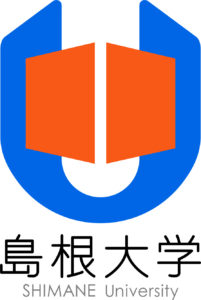 On December 17, we had an online Hibakusha Testimony (with English interpretation) for the students taking the Global Understanding course at The Center for Foreign Language Education, Shimane University.
On December 17, we had an online Hibakusha Testimony (with English interpretation) for the students taking the Global Understanding course at The Center for Foreign Language Education, Shimane University.
Over 45 students and teachers joined online from Japan, Taiwan, Costa Rica, and the U.S.
Before hearing the testimony, WFC gave a short introduction on the “History of Hiroshima.”
Then, Mr. Goro Nishida, who experienced the atomic bombing at the age of three shared his testimony.
During the Q&A, unique questions from a student’s perspective were asked, also helping us to learn.
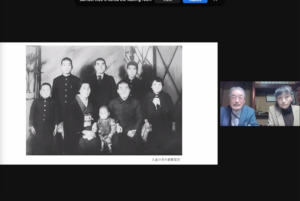 |
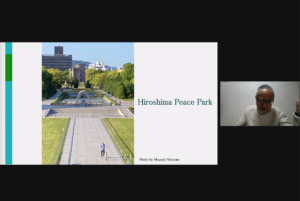 |
Providing opportunities for people from around the world to hear testimonies from hibakusha is an important mission of WFC.
We would like to thank Carmella Lieske who contacted us and worked with us to make this happen, and for all of the help from the faculty and staff at The Center for Foreign Language Education.
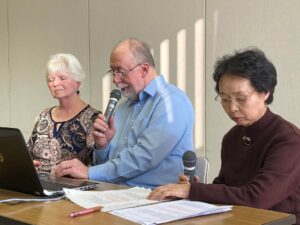 On Saturday, November 20th, 2021, WFC participated in the “22nd International Festa.”
On Saturday, November 20th, 2021, WFC participated in the “22nd International Festa.”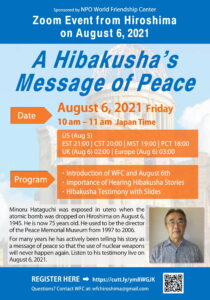
The central mission of WFC, formed in 1965, has been to provide a place where hibakusha (A-bomb survivors) could give their testimonies. Last year, due to the pandemic, people could not come to Hiroshima to hear their stories. So, this year, we are bringing a hibakusha to you. We do not want another year of unheard testimonies!
On August 6,2021, 76 years since the atomic bomb was dropped over Hiroshima, we are holding an online event to hear a hibakusha tell his story.
The event will be in English with hibakusha testimony given in Japanese with English translation.
We invite everyone to sign up and join us online on August 6th.
CLICK HERE to REGISTER
—————————————-
Zoom Event from Hiroshima on August 6, 2021
“A Hibakusha’s Message of Peace”
Date/Time
Japan (Aug 6): 10am-11am
USA (Aug 5): EST 21:00 | CST 20:00 | MST 19:00 | PCT 18:00
UK (Aug 6): 02:00
Europe (Aug 6): 03:00
Program
- Introduction of WFC and August 6th
- Importance of Hearing Hibakusha Stories
- Hibakusha Testimony with Slides
Speaker: Minoru Hataguchi
Minoru Hataguchi was exposed in utero when the atomic bomb was dropped on Hiroshima on August 6, 1945. He is now 75 years old. He used to be the director of the Peace Memorial Museum from 1997 to 2006. For many years he has actively been telling his story as a message of peace so that the use of nuclear weapons will never happen again.
Listen to his testimony live on August 6, 2021.
—————————————–
CLICK HERE to REGISTER
 To all the people involved in WFC,
To all the people involved in WFC,
Thank you very much for your warm support and cooperation with the WFC.
As you all know, the number of positive cases of the new coronavirus has been increasing in Hiroshima City since early April. It is now at an unacceptable high level for the WFC; therefore, we would like to inform you of the following:
Effective immediately, April 29, 2021, all English conversation classes, events and activities will be held online only.
We will be closed for a period of time until the number of infected people in Hiroshima starts to decrease, and safety is confirmed. Please refrain from visiting the WFC and send your messages via email.
Thank you very much for your understanding and cooperation.
We hope that the new coronavirus will be resolved as soon as possible, and we sincerely hope for your safety and health.
WFC Chair, Michiko Yamane
WFC Directors, Roger & Kathy Edmark
The Tanimoto Peace Foundation, in partnership with the Hiroshima World Friendship Center, is offering an Internship Scholarship to up to three motivated individuals to come to Hiroshima for one month. The purpose of their study is to learn about, research about, participate in and write about one of the four pillars of the Tanimoto Peace Foundation: History, Peace Education, Art and Spirituality.
The internship will take place from July 4 – August 1, 2020 in Hiroshima, JAPAN.
Qualifications: The TPF Intern should be:
- 18 years old at the time of arrival in Hiroshima
- Interested in the history of Hiroshima and the atomic bomb
- Open-minded and adaptable to new situations
- Well-organized and a hard worker
- Exploring life’s questions
- Seeking peace internally as well as externally
- Recommended by a faculty member
- Familiarity with Japanese language would be useful, but not necessary
The Scholarship will include:
- Round-trip airfare from your nearest international or connecting airport to Hiroshima
- Lodging in Hiroshima at the World Friendship Center
- Per diem allowance of ¥3000 (1 approx. $30)
- Travel within Japan for research purposes
- The Scholarship will not include health coverage or transportation to your airport.
The Intern is expected to:
- Sign and meet all terms of the Contract (to be sent after acceptance)
- Reside and work at the World Friendship Center and assist them in their daily activities
- Participate in TPF four-pillar activities
- Pursue independent research related to the Intern’s area of interest
- Make a presentation of research project at the end of the Internship
- Write a ten-page report or submit an art project within one month after the Internship, reports and art project to become property of TPF
- Write a two-page evaluation of the internship program within one month of the Internship
- Become part of the TPF Alumni group
Application:
- Cover letter of introduction and CV
- Essay: “Why I want to spend a month in Hiroshima” (500 words) based on one of the TPF pillars
- Letter of Recommendation from faculty member (to be sent separately)
- Deadline for receipt of application is April 10. Interviews will be conducted online between April 15-20 and final selection by April 25.
- Application materials should be sent to rklein@gol.com
Cancellation: TPF will continue to monitor the health risks of coming to Japan and will inform accepted Interns by June 1 of the cancellation of the program for 2020.
Attachments:
Tanimoto Peace Foundation website: http://tanimotopeacefoundation.org/about/
World Friendship Center website: https://www.wfchiroshima.org/english/
Further questions should be sent to Dr. Ron Klein, rklein@gol.com